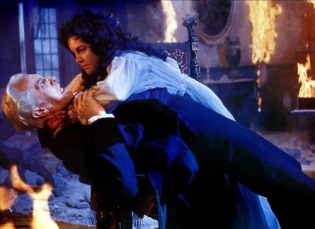Back in 1960, American International Pictures took a gamble. Known for making low-budget black and white features to use in double bills, the company decided to make a larger budgeted colour film when they feared the market for the former was declining. The result was The Fall of the House of Usher (also known as the truncated House of Usher), scripted by Richard Matheson and the first in what would become a series of eight films that director Roger Corman would helm based on the work of author Edgar Allan Poe. Thanks to the lovely folk at Arrow, the film received its UK Blu-ray debut last month. And boy is it pretty.
Usher tells the tale of a young Philip Winthrop (a slightly wooden Mark Damon) who travels to the desolate Usher mansion to visit his fiance Madeline Usher (a beautiful and eerie Myrna Fahey). There he meets Madeline’s brother Roderick (Vincent Price), who is opposed to idea of their union, believing that the Usher bloodline is cursed by some madness that will only continue if Madeline and Philip get married. Desperate to take her away from her brother, Philip manages to persuade Madeline to leave with him, but will Roderick, or the Usher mansion itself, let them?
The film is a great watch, a slow burning tale of madness focusing of psychological decline and the influence of environments. The star is, of course, Vincent Price but the mansion itself gives its human cast a run for their money. Price might come across as a little camp in his portrayal but when faced with the force of the house’s presence, it’s a perfect fit. Thanks to the transfer that Arrow have released (taken from a restoration done by MGM), the mansions madness has never felt more real or looked so stunning. The colours are rich and, at times, sickly, the fog in the desolate swap that surrounds the property is more uninviting and foreboding and the large crack in the mansion’s wall casts a greater shadow over the players than ever before. Simply put, it brings the house back to life, cementing it as the real villain of the picture. One even had to remind themselves that Corman made the film on a $300,000 budget; the film here looks more lavish than any version I have watched previously, a testament to Corman’s, now well-known, ability to deliver well crafted films within monetary constraints.
If the quality and beauty of the films transfer aren’t enough to make you part with your cash, then the extras certainly should. All are worthy of their long running time; in-depth analysis and anecdotal history of various departments and the film’s production proving very informative. There are two brilliant interviews, one with director Joe Dante and one with horror expert Jonathan Rigby, which provide the most insight (covering everything from novel to film comparison, costume, set design, production history, score) and are well worth buying the release for. Also included is a great video essay exploring the film’s relationship to Poe’s original short story and a nice little archival interview with Price which shows him to be friendly, engaging, funny and polite. An audio commentary by Corman and collector’s booklet provide the standard extras that audiences expect from Arrow releases.
I’ve seen some who have argued that it’s not the most deserving of the Poe/Corman cycle to be released first but its a wonderful start, and a most deserving way to spend your cash and update your Blu-ray collection.



